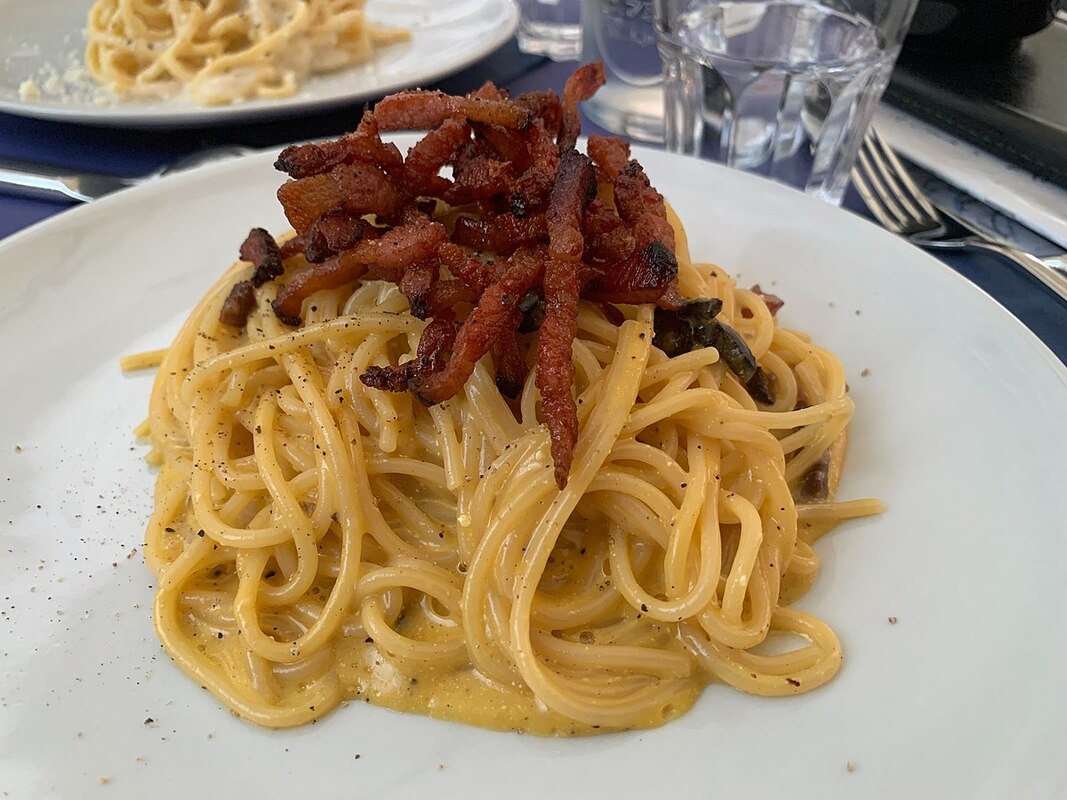 Robot8A, CC BY-SA 4.0
Robot8A, CC BY-SA 4.0 The October/November/December 2023 edition of AAA Explorer had an interesting article entitled The Great Roman Pasta Mystery. In it the author, David Farley, explored the origins of pasta carbonara. The dish, a luscious mixture of egg, pasta, guanciale, ground pepper and pecorino cheese, is a distinctly Roman dish. My Americanized version uses bacon instead of guanciale, parmesan for pecorino, and adds evaporated milk for creaminess..
The mystery is why there are no old recipes for the dish that is considered traditional. The first published recipe dates from 1952. After talking with many food experts, Farley concludes that pasta carbonara was invented by a clever Roman chef during World War Two, but in the aftermath of war, Italians, hungry both physically and emotionally, forgot the newness of the dish and adopted it into their traditions.

Ferracci asserts that a Roman chef, knowing that Americans ate eggs and bacon for breakfast, managed to pick up some of the powdered egg and dried bacon rations that were on the black market. Roman food historian Emilio Ferracci explained to Farley that American soldiers in Rome were known to eat something they called “spaghetti breakfast,” which included these ingredients. Romans began eating the dish, too, adapting it with local ingredients.
 Sumeet Jain from San Francisco, USA, CC BY-SA 2.0
Sumeet Jain from San Francisco, USA, CC BY-SA 2.0 Spaghetti carbonara is not the only example of food influenced by the military. In her book Combat-Read Kitchen, author Anastacia Marx de Salcedo explored how many of the foods Americans eat were first created to feed the military. One example is cheese. During World War II, American GIs craved cheese, but it was heavy and difficult to store and ship. Attempts to dry the product were successful on many fruits, vegetables and eggs did not work for cheese, which crumpled. However, after much experimentation, a USDA dairy scientist named George Sanders developed a cheese powder that was shelf stable and tasted good. Two years later the war ended and the military found itself with tons of dehydrated cheese that they no longer needed. Their solution was to sell it back to food manufacturers at steep discounts. One company who took advantage of this were the Frito Company, who mixed the cheese powder with cornmeal and water and introduced Cheetos to the nation in 1948. The other company that benefitted was Kraft, which had begun experimentation with processed cheeses before the war, but now changed their ubiquitous Kraft Dinners to use the powder instead of grated cheese.
It’s hard to think of Cheetos as a bi-product of the military/industrial complex, but it is!
It’s hard to think of Cheetos as a bi-product of the military/industrial complex, but it is!
Spaghetti Carbonara
This version is very American, and may be similar to the original version whipped up by Roman chefs who wanted to sell their food to American GIs. It isn't fancy, but it is made with items that are typically in an American home and are shelf stable. This is rich comfort food at bargain prices.
Cook al dente: 4 servings (8 oz) spaghetti. Drain in colander.
Cook until crisp: 2 slices bacon. Set aside on paper towels, wipe out the pan.
Combine and heat in pan until thick: 1 beaten egg, 1 cup evaporated milk, 1/2 cup frozen peas, 1/4 cup chopped red pepper.
Stir in: 1/2 cup parmesan cheese, the crumbled bacon, and pasta.
Serves 4
Cook until crisp: 2 slices bacon. Set aside on paper towels, wipe out the pan.
Combine and heat in pan until thick: 1 beaten egg, 1 cup evaporated milk, 1/2 cup frozen peas, 1/4 cup chopped red pepper.
Stir in: 1/2 cup parmesan cheese, the crumbled bacon, and pasta.
Serves 4
Jennifer Bohnhoff writes historical fiction for middle grade through adult readers. You can learn more about her and her books here.





No comments:
Post a Comment